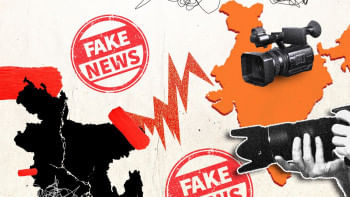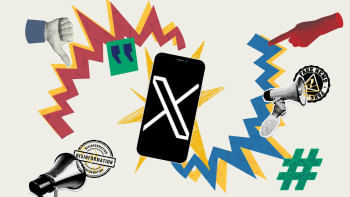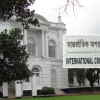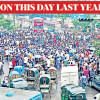Canards of a prejudiced neighbour

The July massacre and the consequent second liberation of Bangladeshis have taken the world by surprise. At a time when millions in Bangladesh are celebrating the overthrow of Hasina's brutal dictatorship, when several hundred families including those of Abu Sayed, Mugdho, and Faiyaaz, are beginning to sense that the wheels of justice have begun to roll, when various countries, international development and rights bodies, civil society organisations and the global media are beginning to absorb and appreciate the courage, tenacity, and commitment of the young heroes, various actors in Bangladesh's next door neighbour (political leadership and the mainstream media, in particular) are busy crafting a narrative denying and undermining the magnificent achievements of the new generation of "freedom fighters."
In the final days of Hasina's regime, the decision to unleash armed Awami goons on the defenceless protesters and the subsequent mobilisation of the security forces with the order to "shoot on sight" (duly executed on a number of occasions, killing scores of people), and the indiscriminate use of tear gas, sound grenade, armoured personnel carriers and helicopters to disperse and terrorise the protesters made it amply clear to the people of Bangladesh and discerning international observers that the Awami regime has reached its nadir. The state's myopic policy of resorting to intimidation and brute force only contributed to further hardening the resolve of the protestors. By August 3, their nine-point demand coalesced into one-point, the unconditional resignation of the government.
On the fateful day of August 5, the students' Dhaka siege programme in realisation of the one-point demand was countered by the state by imposing a stringent curfew backed by the threat of using lethal force. When the former prime minister ordered the siege be quashed "by any means," the armed forces' decision not to open fire on the unarmed protestors sealed the fate of the regime, leading Hasina to flee the country. While her departure triggered joyous celebrations all over the land, the news of killing of more than 100 people on the final two days let loose frenzied outrage, resulting in ransacking of the prime ministerial office and residence in Dhaka, and attacking and, in some instances, torching of the offices of the Awami League and homes and facilities of its leaders.
The violence that ensued was the result of a combination of outrage at the indiscriminate killing of fellow protestors and the venting of a long-drawn pent up frustration of a repressed, disenfranchised populace, who were left out of the "economic miracle" conjured by the regime and subjected to denial of fundamental rights including those of assembly, expression and dissent and also ill treatment, seizure of properties, denial of justice and humiliation by the ruling elite in cahoots with the state agencies.
The glorious struggle of the youth of Bangladesh that culminated in the overthrow of a despot through sacrificing several hundred lives received widespread felicitations from all over the world. Unity, resilience, and creativity demonstrated by the student leadership in steering through the movement against all odds became the topic for discussion in every quarter that value justice, freedom, and liberty, both at home and abroad. In contrast to such a dispensation of triumph and positive image of Bangladesh's new found freedom, the dominant and influential sections of Indian commentators (diplomats, strategic experts, and "Bangladesh observers") and that of the media conjured up a conspiracy theory claiming that the students' movement was being "manipulated," if not "steered" by opposition political parties, such as the Bangladesh National Party (BNP) and Jamaat-e-Islami.Nothing can be further from the truth.
The quota reform movement was an autonomous, organic movement of the students. Though it was initiated by the students of public universities, the atrocities committed against them by the ruling party thugs, blatantly aided by the members of law enforcement agencies, galvanised the students of schools, madrasas, colleges and private universities to join the ranks. As the casualties mounted as a result of trigger-happy response of the state, siblings, parents, guardians and mass people from all walks of life joined the students, swelling the ranks of the protesters. By then they had overcome the fear to face live ammunition. All along there was conscious effort by the student "coordinators" (leaders) not to provide the government any pretext to brand the movement as proxy of the opposition parties. During this entire episode, being mindful of likely public backlash for usurping the movement, political parties such as the BNP and Jamat-e-Islami had little option but to maintain a low profile, let alone had any opportunity to direct or manipulate it, as claimed by Delhi and Kolkata based pundits.
Some Indian observers also beat the drum that the Pakistani spy agency, ISI, had a hand in orchestrating the protests to dislodge the Hasina government. Others have pointed fingers at China. If indeed such collusion existed, is it not incumbent on those observers to furnish credible evidence to establish the veracity of such claims?
Collective leadership with designated coordinators in major educational institutions and districts was a distinguishing feature of the movement. As and when top leaders got arrested, detained, or were forced to hide, the next tier of coordinators assumed the role and steered the struggle, often by declaring programmes that ensured the continued engagement of the masses. The unflinching commitment to unity and resilience frustrated all efforts (detention, abduction, and torture) of the state agencies to bring about a fissure in the leadership. After the state violence reached its zenith, the one-point demand for the resignation of the government was taken by the students and the students alone. Therefore, to ascribe the success of the protest movement to opposition political parties or external elements not only reflects the stark failure to recognise the depth of the students' agency and ingenuity, it also manifests the wretched level of understanding of the "Bangladesh observers" of India as to the ground realities of Bangladesh politics.
The claims of widespread violence targeting the Hindu minority were another issue of concern of the prejudiced Indian media and the intellectual elite. The matter also featured in the Indian prime minister's message to the newly installed chief adviser of Bangladesh. It is true, that public backlash against the Awami League leaders and activists engaged in excesses during the party's 15-year rule did impact on some members of the Hindu community. On August 9, Bangladesh Hindu Buddhist Christian Oikya Parishad reported that 205 cases of persecution, which includes the burning of temples, sexual assault, and even murders, on minority communities took place in 52 districts since the former prime minister's resignation occurred four days prior.
However, there is also burgeoning evidence that the issue was blown out of proportion by the vested quarters. Images of a prominent Hindu cricketer's home being torched, of Hindu women being gang raped and killed; of Hindu community members trying to cross the border en masse to escape engulfing violence that was rife in the social media were subsequently proven to be fake.
Fact checkers have found that many of the fake posts on social media about "widespread persecution" of Hindus in Bangladesh were posted from various Indian accounts. They noted, "While some attacks on Hindus did occur, houses were also vandalised and burned in Muslim communities." Instead of viewing them as incidents of "communal violence" the attacks were targeted at Awami League leaders and supporters rather than at individuals based on their religious identity. For political expediency "these events were given a communal colour rather than being portrayed as politically motivated." After reaching out to sources in some of the affected districts, Al Jazeera "discovered that the attacks on Hindu households were not driven by religious identity but by political affiliations." The BBC's fact-checking unit, BBC Verify, also arrived at a similar conclusion.
The prejudiced Indian intellectual elite and the media outlets' hypocrisy is palpable by their collective silence about the atrocities committed by the Awami League goons and members of the law enforcement agencies. From their interventions in the TV talks shows, opinion pieces and statements, it is obvious that the killing of hundreds of unarmed youths by illegal use of firearms by Hasina government and injury of several thousand have hardly been reported and thus far failed to stir the conscience of these champions of liberalism who interestingly have passionately condemned the mob vandalism of private and state property, including statues of Sheikh Mujibur Rahman.
Such insensitive and undesirable reaction by the mainstream Indian intellectual elite and its cohort media to the July massacre should not come as a surprise to ordinary Bangladeshis. They are well aware that it was the Indian government that continued to provide critical support to a regime that usurped power by conducting three sham exercises (falsely dubbed as general elections) in 2014, 2019, and 2024. Time has come for the Indian political establishment to discard its myopic policy of trying to shore up the fallen regime that was overthrown by a popular revolution of freedom loving Bangladeshis, particularly the young people, who aspire to be treated with dignity and respect by its neighbour.
Dr C R Abrar is an academic with an interest in human rights issues.
Views expressed in this article are the author's own.
Follow The Daily Star Opinion on Facebook for the latest opinions, commentaries and analyses by experts and professionals. To contribute your article or letter to The Daily Star Opinion, see our guidelines for submission.

 For all latest news, follow The Daily Star's Google News channel.
For all latest news, follow The Daily Star's Google News channel. 










Comments